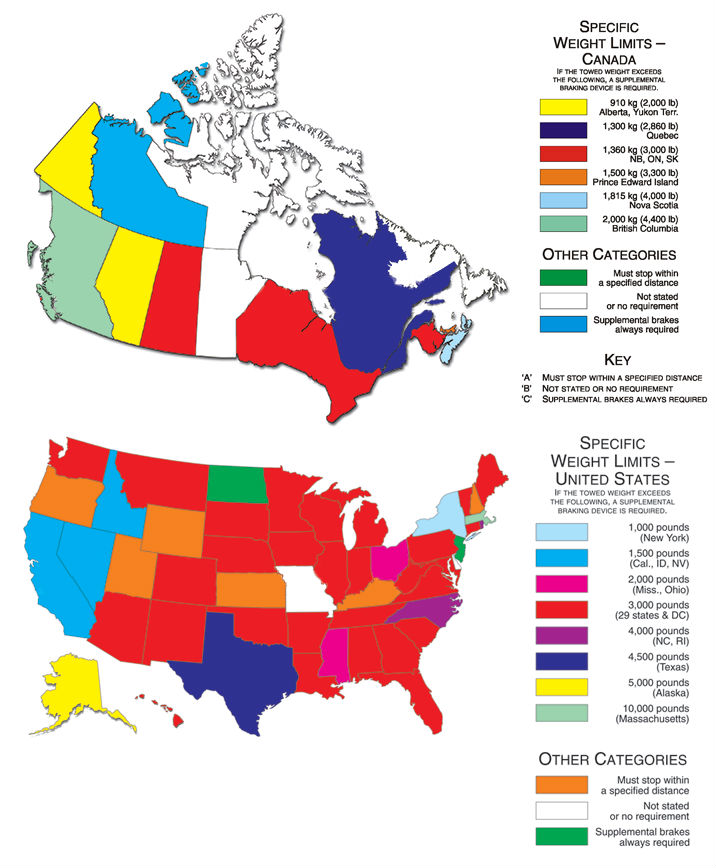Braking Requirements
Every state has its own braking requirements for trailers and may even vary on the type of trailer. If you are traveling from state to state on a regular basis, you need to comply with their laws and regulations.
Some states (North Dakota & Wisconsin) require all trailers to be braked regardless of their size and load, while the rest have variances between 1000 lbs right up to 10,000 lbs.
The maximum weight rating is based on the gross trailer weight (GTW), which is the total weight of the trailer including everything that is in or on the trailer. GTW is the same as GVWR (Gross Vehicle Weight Rating) when referring to a trailer.
Ideally all trailers should be braked although it may not be overly practical in some circumstances, but it is recommended that trailers over 3000 lbs have brakes fitted.
Where brakes are fitted, they need to function correctly and regular maintenance is required to ensure their reliability. Brakes give the trailer and its load stability when braking and reduces the chance of a serious accident if you need to stop suddenly.
Most states require breakaway brakes to be fitted if brakes are fitted to the trailer. Breakaway brake systems are emergency brakes which will apply the trailer brakes if the trailer separates from the towing vehicle.
For more information on Breakaway brake systems - Click Here.
Before building your trailer, check your state laws regarding brakes and breakaway systems as well as any state you anticipate towing the trailer through.

Maps sourced from AAA Digest
| Max Weight | Breakaway | Max Weight | Breakaway | |||
| State | without Brakes | Brakes | State | without Brakes | Brakes | |
| Alabama | 3000 | Y | Alberta | 2000 | Y | |
| Alaska | 5000 | Y | British Columbia | 3000 | Y (see Note D) | |
| Arizona | 3000 | Y | Manitoba | 3000 | Y | |
| Arkansas | 3000 | Y | New Brunswick | 3300 | NA | |
| California | 1500 | Y(See Note D) | Newfoundland/Labrador | 9900 | NA | |
| Colorado | 3000 | Y | Nova Scotia | 4000 | Y (See Note E) | |
| Connecticut | 3000 | Y | Ontario | 3000 | NA | |
| Delaware | 4000 | N/A | Prince Edward Is. | 3300 | NA | |
| Florida | 3000 | Y | Quebec | 2860 | Y (See Note E) | |
| Georgia | 2500 | Y | Saskatchewan | 3000 | Y | |
| Hawaii | 3000 | Y(See Note E) | ||||
| Idaho | 1500 | Y | ||||
| Illinois | 3000 | Y(See Note F) | Notes | |||
| Indiana | 3000 | Y | A Must be able to stop within 40' from 20mph | |||
| Iowa | 3000 | Y(See Note E) | B If trailer is 7' high x 7' wide | |||
| Kansas | See Note A | N/A | C Or if trailer weight (GTW) is more than 40% of | |||
| Kentucky | 3000 | N/A | tow vehicles weight | |||
| Louisiana | 3000 | Y | D Brake must hold for 15 minutes | |||
| Maine | 3000 | N/A | E For Trailers over 3000# GTW | |||
| Maryland | 3000 | Y | F For Trailers over 5000# GTW - includes safety inspection | |||
| Massachusetts | 10000 | N/A | G For Trailers over 6000# GTW | |||
| Michigan | 3000 | N/A | ||||
| Minnesota | 3000 | Y(See Note G) | ||||
| Mississippi | 2000 | Y | ||||
| Missouri | 3000 | Y | ||||
| Montana | 3000 | Y(See Note E) | ||||
| N. Carolina | 1000 | N/A | ||||
| N. Dakota | All | N/A | ||||
| Nebraska | 3000 | Y | ||||
| Nevada | 1500 | Y | ||||
| New Hamp. | 1500 | N/A | ||||
| New Jersey | 3000 | Y | ||||
| New Mexico | 3000 | Y | ||||
| New York | 3000 | N/A | ||||
| Ohio | 2000 | Y | ||||
| Oklahoma | 3000 | Y | ||||
| Oregon | 3000 | N/A | ||||
| Pennsylvania | 3000 | Y | ||||
| Rhode Island | 4000 | Y | ||||
| S. Carolina | 3000 | Y | ||||
| S. Dakota | 3000 | Y(See Note E) | ||||
| Tennessee | 3,000 | Y | ||||
| Texas | 4,500 | Y(See Note E) | ||||
| Utah | 2000 | Y(See Note E) | ||||
| Vermont | 3,000 (See Note B) | Y | ||||
| Virginia | 3000 | Y | ||||
| W. Virginia | 3,000 (See Note C) | Y | ||||
| Washington | 3000 | Y | ||||
| Wisconsin | All | N/A | ||||